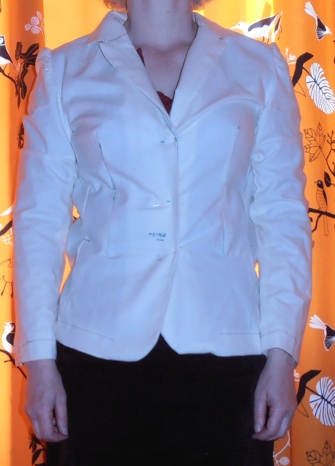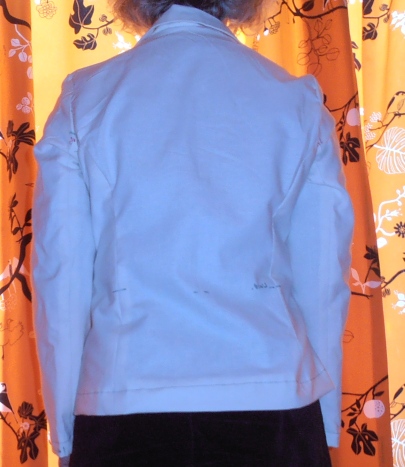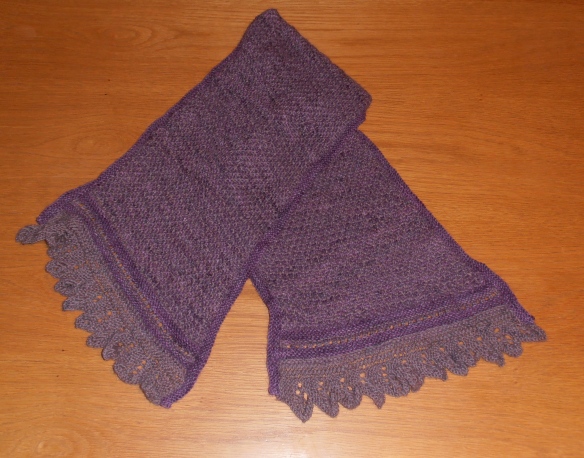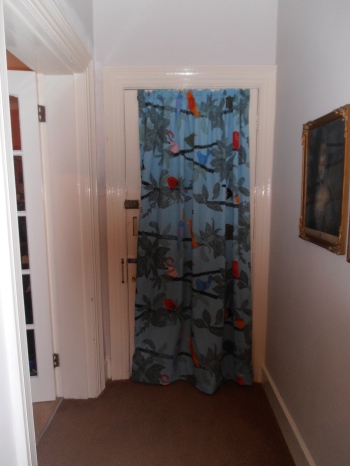Last weekend I moved flat and spent most of the week unpacking and running backwards and forwards to Ikea. Funny, I’ve never had any problems with their products in the past but two items I bought this week had faulty components. Ikea furniture is great but their customer service is possibly the worst. Anyway most things have been unpacked now. I just need to work out how to fit all our pots and pans into our incredibly badly designed kitchen (large but with no storage or work space!)
 I took the opportunity of a few quiet hours this weekend to make a toile of my jacket. The
I took the opportunity of a few quiet hours this weekend to make a toile of my jacket. The
pattern I am using is Burda 102 03/2013. Thank you for all your useful suggestions from my last post particularly the link to the tailoring sew along. Having read through this I think I will follow her construction method as it’s my first jacket and it’s clear this is taking me into a whole new world of techniques.
Some thoughts occurred to me as a I made my toile;
Firstly, I should probably try to be more accurate when tracing Burda patterns. I originally started by trying to trace onto manilla parcel paper using tailors carbon paper and a wheel, however I didn’t find this very satisfactory. It’s difficult to get carbon paper of any size and if you move it as you trace you can knock your pattern out of kilter. Also the marks left are quite indistinct, I really need large sheets of dark coloured carbon paper for this to be successful but I’ve not found a source in London as yet.
A friend suggested a better (though slightly more destructive way) would be to use a spiked wheel. To do this I place a foam board on my kitchen work surface, then a layer of brown paper and lastly the pattern. The spiked wheel punctures through to the foam board which protects the work surface. I use the kitchen work surface rather than a table as its slightly higher so puts less strain on my back. This works very well and gives me a clear line. The problem is that I then go over the line free hand with a thickish felt pen. I think I need to rethink this step and use a finer pen and probably guide it with a ruler or French curve.
How do you trace your Burda patterns? Have you found a good source of carbon paper in the UK?
Secondly, I need to get a grips with sewing notched collars. I did this one late at night using a mixture of Burda’s instructions and my own intuition. It didn’t really help that I had obviously missed the mark on the pattern piece where the notch was supposed to go. This morning I looked it up in my DK Sewing Book and found a much simpler method of making them.
 Thirdly, the dart is quite tricky on this jacket and incorporates a horizontal seam which runs at right angle to the bottom of the dart legs. If I do make a mess of this the pocket pieces will hide the worst of it, but for myown satisfaction I’d like to get it right.
Thirdly, the dart is quite tricky on this jacket and incorporates a horizontal seam which runs at right angle to the bottom of the dart legs. If I do make a mess of this the pocket pieces will hide the worst of it, but for myown satisfaction I’d like to get it right.
Lastly, I really need to spend some time practising sleeves. Sometimes they work and sometimes they don’t. I have a feeling the difference is to do with the amount of ease in a sleeve (but on this jacket I seem to have one sort of ok and the other really bad so that doesn’t apply here). I’m also really bad at working out which is the front and which is the back of a sleeve
 So what do you think of the fit on this toile (apart from the fact that I am so lopsided)? I find it difficult to tell given that the calico I’m using is very light and drapey and I intend to make the jacket in a medium weight wool. I think it would be more flattering if it were a bit more fitted around the waist, maybe starting with a smaller size might help.
So what do you think of the fit on this toile (apart from the fact that I am so lopsided)? I find it difficult to tell given that the calico I’m using is very light and drapey and I intend to make the jacket in a medium weight wool. I think it would be more flattering if it were a bit more fitted around the waist, maybe starting with a smaller size might help.
I’ve got a curved wrinkle that runs from the armscye over the top of my breast, on the pictures it only came out on one side but it’s apparent on both when I stand in front of the mirror. I probably need to pinch that out, but I need to be careful of not taking fabric out across my bust as it fits quite well there. Have you any suggestions as to how I fix this?
I’ve also got a bit of dragging under the bust where I think it’s being pulled from the back, I have a broad back so I may be able to fix this by letting out a bit on the arm/side seams.
Lastly, the back looks too big to me. Almost as if I could do with a smaller size. Again it’s difficult to tell in the calico as the added structure of a firmer fabric might help.


 I have written
I have written 

 Thirdly, the dart is quite tricky on this jacket and incorporates a horizontal seam which runs at right angle to the bottom of the dart legs. If I do make a mess of this the pocket pieces will hide the worst of it, but for myown satisfaction I’d like to get it right.
Thirdly, the dart is quite tricky on this jacket and incorporates a horizontal seam which runs at right angle to the bottom of the dart legs. If I do make a mess of this the pocket pieces will hide the worst of it, but for myown satisfaction I’d like to get it right.